Cinema Analysis: Exploring Themes in 'The Lunchbox' (Essay)
VerifiedAdded on 2022/08/29
|6
|1539
|14
Essay
AI Summary
This essay provides an in-depth analysis of the 2013 film 'The Lunchbox,' directed by Ritesh Batra. The essay explores various themes presented in the film, including the efficiency of Mumbai's Dabbawalas, the development of a love affair between two individuals, and the themes of loneliness, woman empowerment, and seizing the moment. The essay highlights the portrayal of Ila, a housewife, and Sajaan, a widower, and their connection through the exchange of notes. It also discusses the character of Shaikh, who embodies the theme of carpe diem, and how the film challenges societal norms. The essay examines the film's editing, narrative, and the impact of its themes on the audience, concluding that 'The Lunchbox' is a unique and thought-provoking piece of Indian cinema. It provides a detailed examination of the characters, their motivations, and the film's overall message.
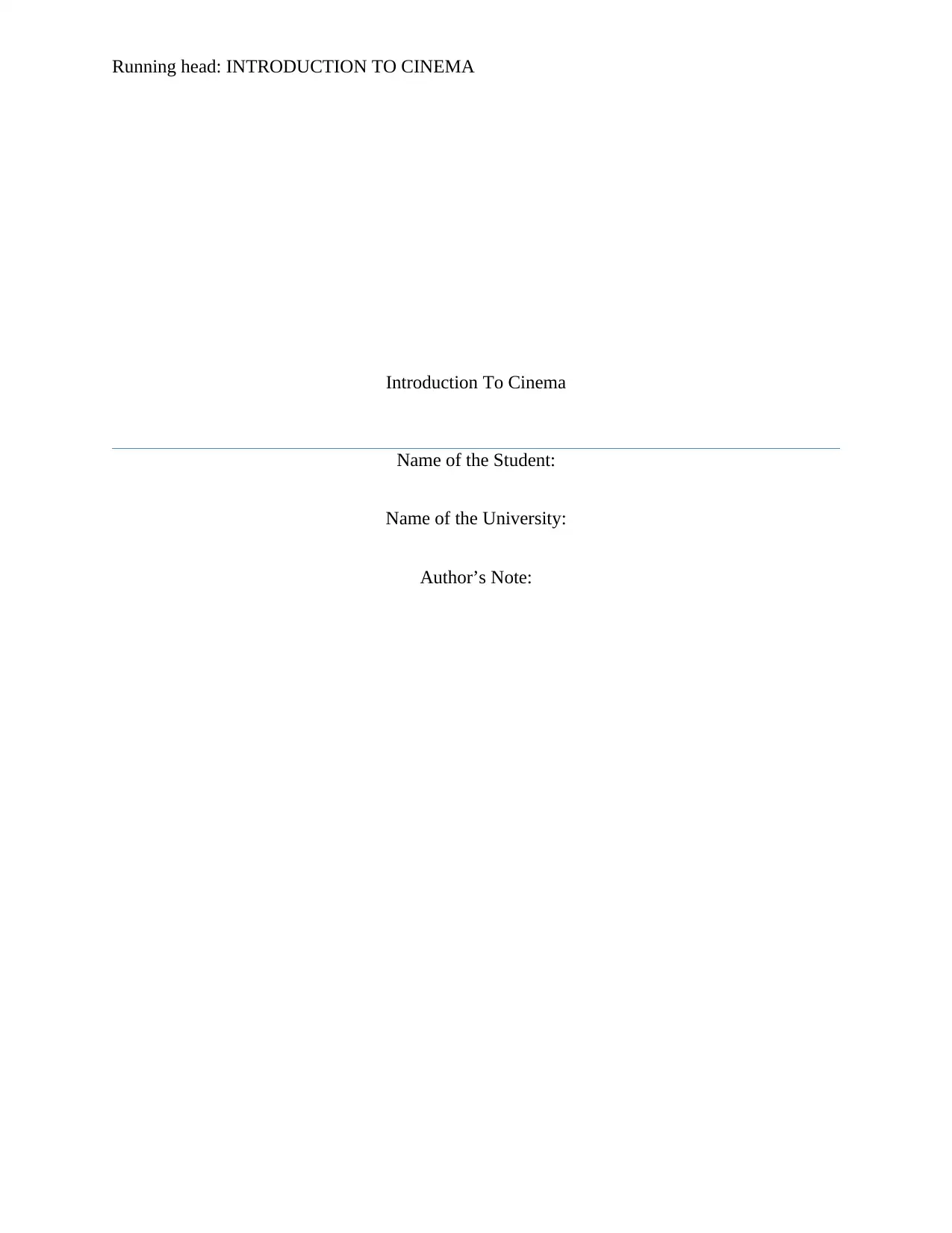
Running head: INTRODUCTION TO CINEMA
Introduction To Cinema
Name of the Student:
Name of the University:
Author’s Note:
Introduction To Cinema
Name of the Student:
Name of the University:
Author’s Note:
Paraphrase This Document
Need a fresh take? Get an instant paraphrase of this document with our AI Paraphraser
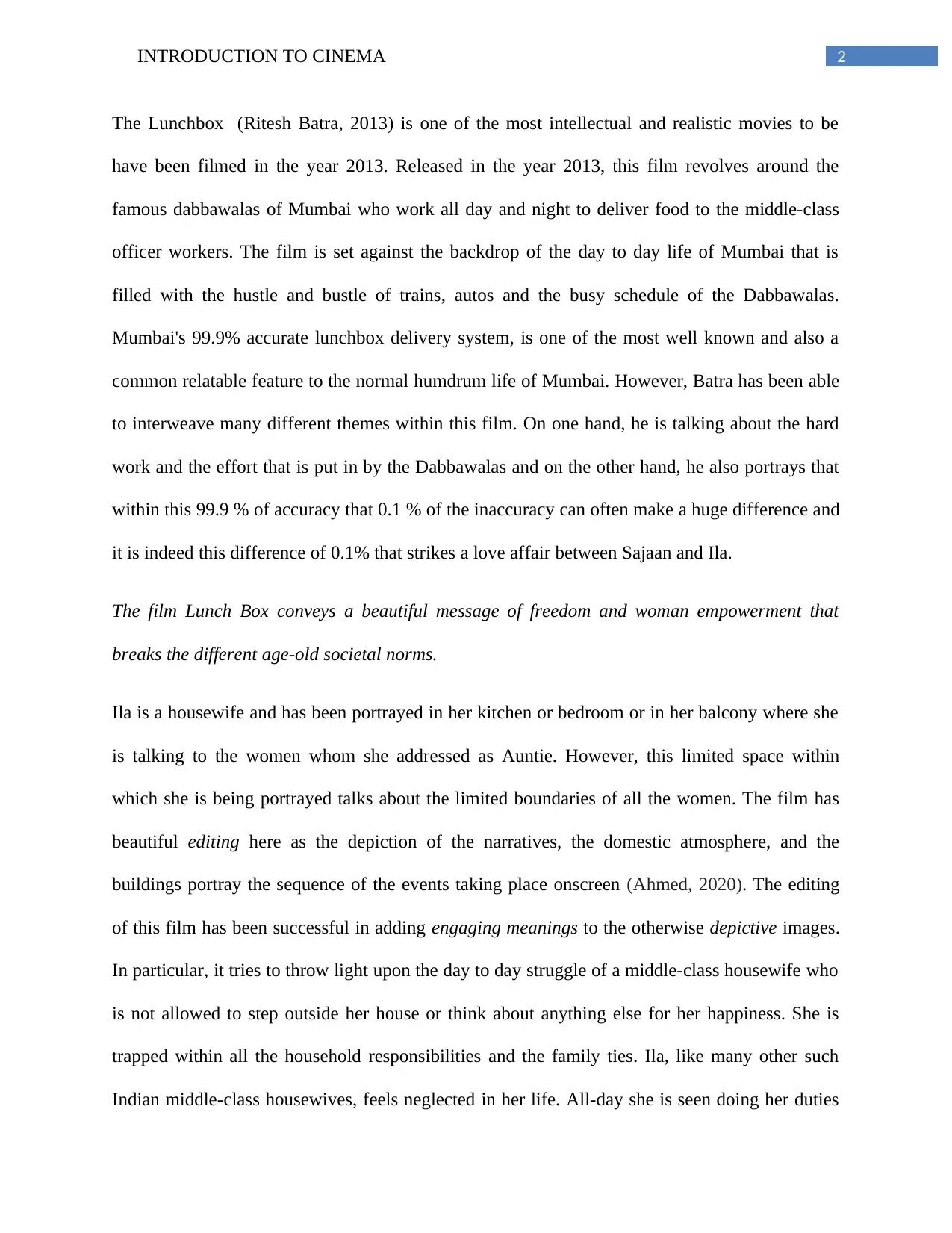
2INTRODUCTION TO CINEMA
The Lunchbox (Ritesh Batra, 2013) is one of the most intellectual and realistic movies to be
have been filmed in the year 2013. Released in the year 2013, this film revolves around the
famous dabbawalas of Mumbai who work all day and night to deliver food to the middle-class
officer workers. The film is set against the backdrop of the day to day life of Mumbai that is
filled with the hustle and bustle of trains, autos and the busy schedule of the Dabbawalas.
Mumbai's 99.9% accurate lunchbox delivery system, is one of the most well known and also a
common relatable feature to the normal humdrum life of Mumbai. However, Batra has been able
to interweave many different themes within this film. On one hand, he is talking about the hard
work and the effort that is put in by the Dabbawalas and on the other hand, he also portrays that
within this 99.9 % of accuracy that 0.1 % of the inaccuracy can often make a huge difference and
it is indeed this difference of 0.1% that strikes a love affair between Sajaan and Ila.
The film Lunch Box conveys a beautiful message of freedom and woman empowerment that
breaks the different age-old societal norms.
Ila is a housewife and has been portrayed in her kitchen or bedroom or in her balcony where she
is talking to the women whom she addressed as Auntie. However, this limited space within
which she is being portrayed talks about the limited boundaries of all the women. The film has
beautiful editing here as the depiction of the narratives, the domestic atmosphere, and the
buildings portray the sequence of the events taking place onscreen (Ahmed, 2020). The editing
of this film has been successful in adding engaging meanings to the otherwise depictive images.
In particular, it tries to throw light upon the day to day struggle of a middle-class housewife who
is not allowed to step outside her house or think about anything else for her happiness. She is
trapped within all the household responsibilities and the family ties. Ila, like many other such
Indian middle-class housewives, feels neglected in her life. All-day she is seen doing her duties
The Lunchbox (Ritesh Batra, 2013) is one of the most intellectual and realistic movies to be
have been filmed in the year 2013. Released in the year 2013, this film revolves around the
famous dabbawalas of Mumbai who work all day and night to deliver food to the middle-class
officer workers. The film is set against the backdrop of the day to day life of Mumbai that is
filled with the hustle and bustle of trains, autos and the busy schedule of the Dabbawalas.
Mumbai's 99.9% accurate lunchbox delivery system, is one of the most well known and also a
common relatable feature to the normal humdrum life of Mumbai. However, Batra has been able
to interweave many different themes within this film. On one hand, he is talking about the hard
work and the effort that is put in by the Dabbawalas and on the other hand, he also portrays that
within this 99.9 % of accuracy that 0.1 % of the inaccuracy can often make a huge difference and
it is indeed this difference of 0.1% that strikes a love affair between Sajaan and Ila.
The film Lunch Box conveys a beautiful message of freedom and woman empowerment that
breaks the different age-old societal norms.
Ila is a housewife and has been portrayed in her kitchen or bedroom or in her balcony where she
is talking to the women whom she addressed as Auntie. However, this limited space within
which she is being portrayed talks about the limited boundaries of all the women. The film has
beautiful editing here as the depiction of the narratives, the domestic atmosphere, and the
buildings portray the sequence of the events taking place onscreen (Ahmed, 2020). The editing
of this film has been successful in adding engaging meanings to the otherwise depictive images.
In particular, it tries to throw light upon the day to day struggle of a middle-class housewife who
is not allowed to step outside her house or think about anything else for her happiness. She is
trapped within all the household responsibilities and the family ties. Ila, like many other such
Indian middle-class housewives, feels neglected in her life. All-day she is seen doing her duties
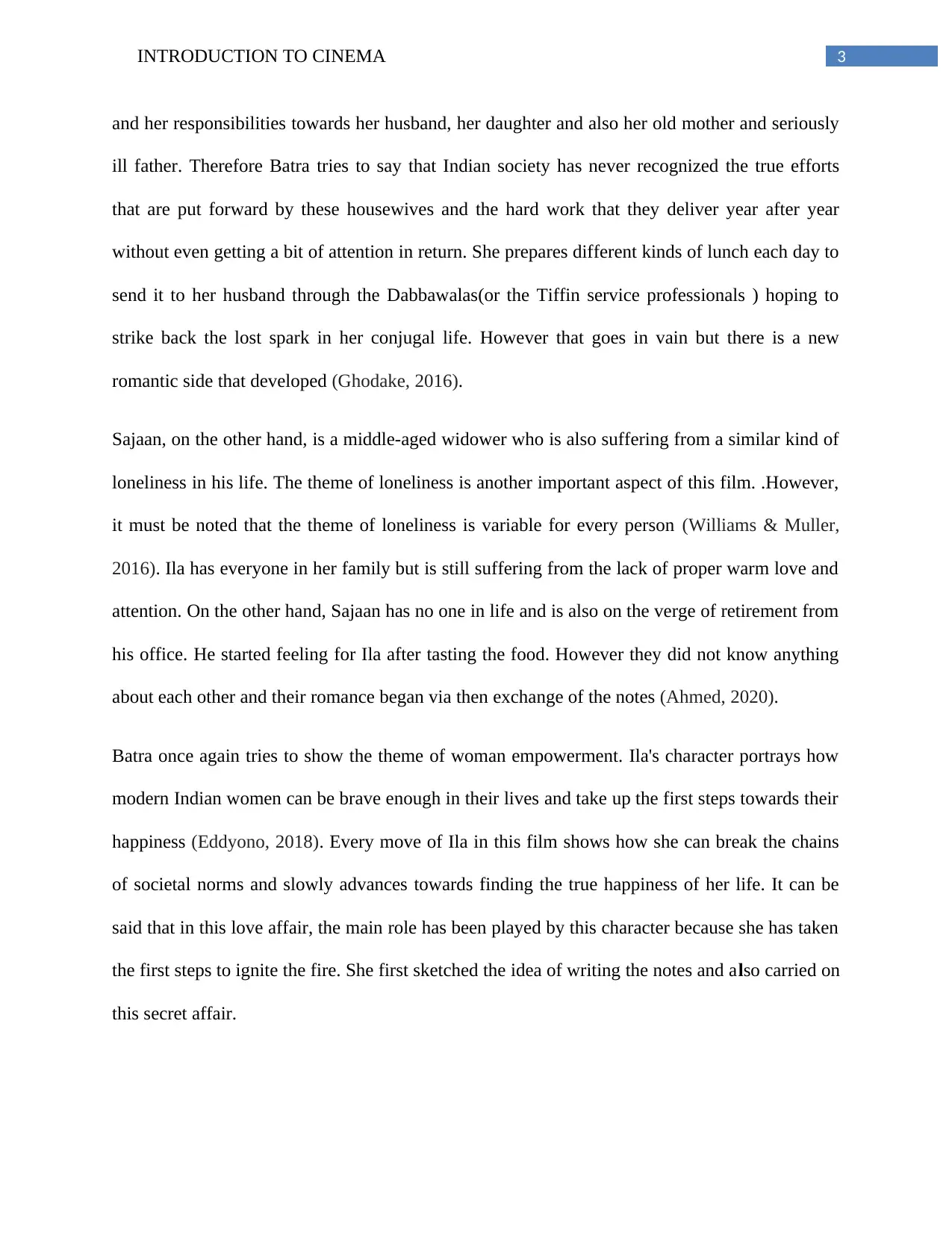
3INTRODUCTION TO CINEMA
and her responsibilities towards her husband, her daughter and also her old mother and seriously
ill father. Therefore Batra tries to say that Indian society has never recognized the true efforts
that are put forward by these housewives and the hard work that they deliver year after year
without even getting a bit of attention in return. She prepares different kinds of lunch each day to
send it to her husband through the Dabbawalas(or the Tiffin service professionals ) hoping to
strike back the lost spark in her conjugal life. However that goes in vain but there is a new
romantic side that developed (Ghodake, 2016).
Sajaan, on the other hand, is a middle-aged widower who is also suffering from a similar kind of
loneliness in his life. The theme of loneliness is another important aspect of this film. .However,
it must be noted that the theme of loneliness is variable for every person (Williams & Muller,
2016). Ila has everyone in her family but is still suffering from the lack of proper warm love and
attention. On the other hand, Sajaan has no one in life and is also on the verge of retirement from
his office. He started feeling for Ila after tasting the food. However they did not know anything
about each other and their romance began via then exchange of the notes (Ahmed, 2020).
Batra once again tries to show the theme of woman empowerment. Ila's character portrays how
modern Indian women can be brave enough in their lives and take up the first steps towards their
happiness (Eddyono, 2018). Every move of Ila in this film shows how she can break the chains
of societal norms and slowly advances towards finding the true happiness of her life. It can be
said that in this love affair, the main role has been played by this character because she has taken
the first steps to ignite the fire. She first sketched the idea of writing the notes and also carried on
this secret affair.
and her responsibilities towards her husband, her daughter and also her old mother and seriously
ill father. Therefore Batra tries to say that Indian society has never recognized the true efforts
that are put forward by these housewives and the hard work that they deliver year after year
without even getting a bit of attention in return. She prepares different kinds of lunch each day to
send it to her husband through the Dabbawalas(or the Tiffin service professionals ) hoping to
strike back the lost spark in her conjugal life. However that goes in vain but there is a new
romantic side that developed (Ghodake, 2016).
Sajaan, on the other hand, is a middle-aged widower who is also suffering from a similar kind of
loneliness in his life. The theme of loneliness is another important aspect of this film. .However,
it must be noted that the theme of loneliness is variable for every person (Williams & Muller,
2016). Ila has everyone in her family but is still suffering from the lack of proper warm love and
attention. On the other hand, Sajaan has no one in life and is also on the verge of retirement from
his office. He started feeling for Ila after tasting the food. However they did not know anything
about each other and their romance began via then exchange of the notes (Ahmed, 2020).
Batra once again tries to show the theme of woman empowerment. Ila's character portrays how
modern Indian women can be brave enough in their lives and take up the first steps towards their
happiness (Eddyono, 2018). Every move of Ila in this film shows how she can break the chains
of societal norms and slowly advances towards finding the true happiness of her life. It can be
said that in this love affair, the main role has been played by this character because she has taken
the first steps to ignite the fire. She first sketched the idea of writing the notes and also carried on
this secret affair.
⊘ This is a preview!⊘
Do you want full access?
Subscribe today to unlock all pages.

Trusted by 1+ million students worldwide
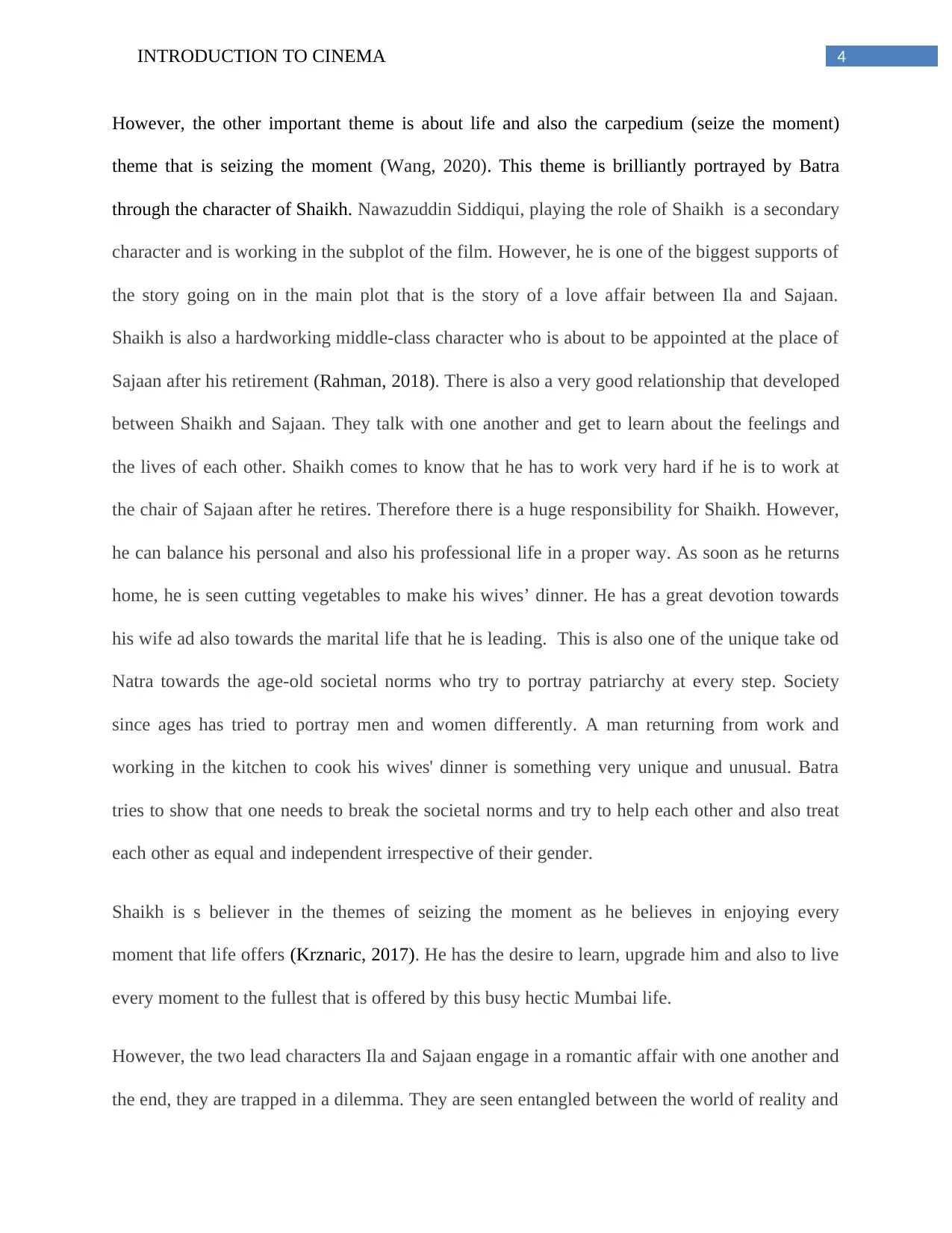
4INTRODUCTION TO CINEMA
However, the other important theme is about life and also the carpedium (seize the moment)
theme that is seizing the moment (Wang, 2020). This theme is brilliantly portrayed by Batra
through the character of Shaikh. Nawazuddin Siddiqui, playing the role of Shaikh is a secondary
character and is working in the subplot of the film. However, he is one of the biggest supports of
the story going on in the main plot that is the story of a love affair between Ila and Sajaan.
Shaikh is also a hardworking middle-class character who is about to be appointed at the place of
Sajaan after his retirement (Rahman, 2018). There is also a very good relationship that developed
between Shaikh and Sajaan. They talk with one another and get to learn about the feelings and
the lives of each other. Shaikh comes to know that he has to work very hard if he is to work at
the chair of Sajaan after he retires. Therefore there is a huge responsibility for Shaikh. However,
he can balance his personal and also his professional life in a proper way. As soon as he returns
home, he is seen cutting vegetables to make his wives’ dinner. He has a great devotion towards
his wife ad also towards the marital life that he is leading. This is also one of the unique take od
Natra towards the age-old societal norms who try to portray patriarchy at every step. Society
since ages has tried to portray men and women differently. A man returning from work and
working in the kitchen to cook his wives' dinner is something very unique and unusual. Batra
tries to show that one needs to break the societal norms and try to help each other and also treat
each other as equal and independent irrespective of their gender.
Shaikh is s believer in the themes of seizing the moment as he believes in enjoying every
moment that life offers (Krznaric, 2017). He has the desire to learn, upgrade him and also to live
every moment to the fullest that is offered by this busy hectic Mumbai life.
However, the two lead characters Ila and Sajaan engage in a romantic affair with one another and
the end, they are trapped in a dilemma. They are seen entangled between the world of reality and
However, the other important theme is about life and also the carpedium (seize the moment)
theme that is seizing the moment (Wang, 2020). This theme is brilliantly portrayed by Batra
through the character of Shaikh. Nawazuddin Siddiqui, playing the role of Shaikh is a secondary
character and is working in the subplot of the film. However, he is one of the biggest supports of
the story going on in the main plot that is the story of a love affair between Ila and Sajaan.
Shaikh is also a hardworking middle-class character who is about to be appointed at the place of
Sajaan after his retirement (Rahman, 2018). There is also a very good relationship that developed
between Shaikh and Sajaan. They talk with one another and get to learn about the feelings and
the lives of each other. Shaikh comes to know that he has to work very hard if he is to work at
the chair of Sajaan after he retires. Therefore there is a huge responsibility for Shaikh. However,
he can balance his personal and also his professional life in a proper way. As soon as he returns
home, he is seen cutting vegetables to make his wives’ dinner. He has a great devotion towards
his wife ad also towards the marital life that he is leading. This is also one of the unique take od
Natra towards the age-old societal norms who try to portray patriarchy at every step. Society
since ages has tried to portray men and women differently. A man returning from work and
working in the kitchen to cook his wives' dinner is something very unique and unusual. Batra
tries to show that one needs to break the societal norms and try to help each other and also treat
each other as equal and independent irrespective of their gender.
Shaikh is s believer in the themes of seizing the moment as he believes in enjoying every
moment that life offers (Krznaric, 2017). He has the desire to learn, upgrade him and also to live
every moment to the fullest that is offered by this busy hectic Mumbai life.
However, the two lead characters Ila and Sajaan engage in a romantic affair with one another and
the end, they are trapped in a dilemma. They are seen entangled between the world of reality and
Paraphrase This Document
Need a fresh take? Get an instant paraphrase of this document with our AI Paraphraser
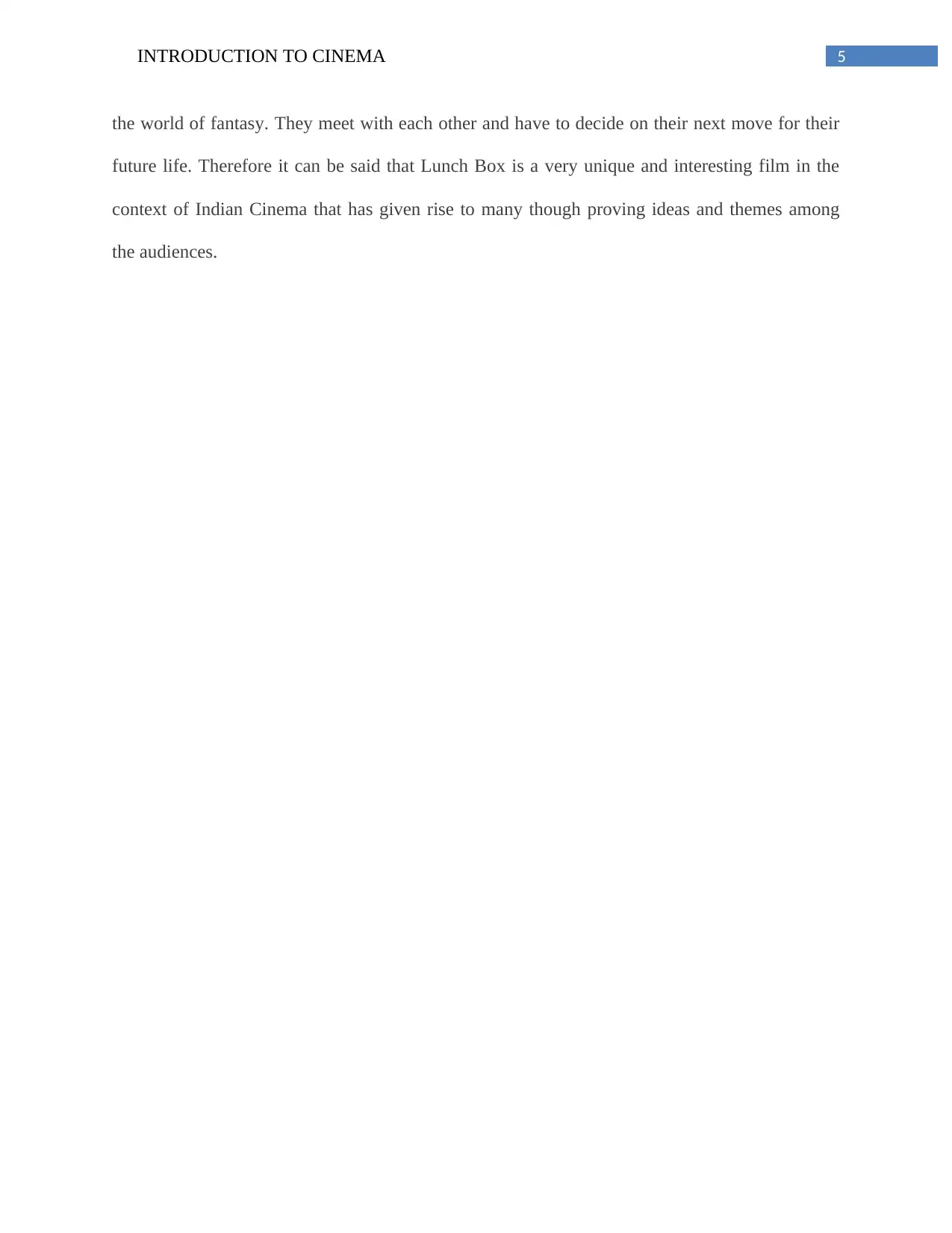
5INTRODUCTION TO CINEMA
the world of fantasy. They meet with each other and have to decide on their next move for their
future life. Therefore it can be said that Lunch Box is a very unique and interesting film in the
context of Indian Cinema that has given rise to many though proving ideas and themes among
the audiences.
the world of fantasy. They meet with each other and have to decide on their next move for their
future life. Therefore it can be said that Lunch Box is a very unique and interesting film in the
context of Indian Cinema that has given rise to many though proving ideas and themes among
the audiences.
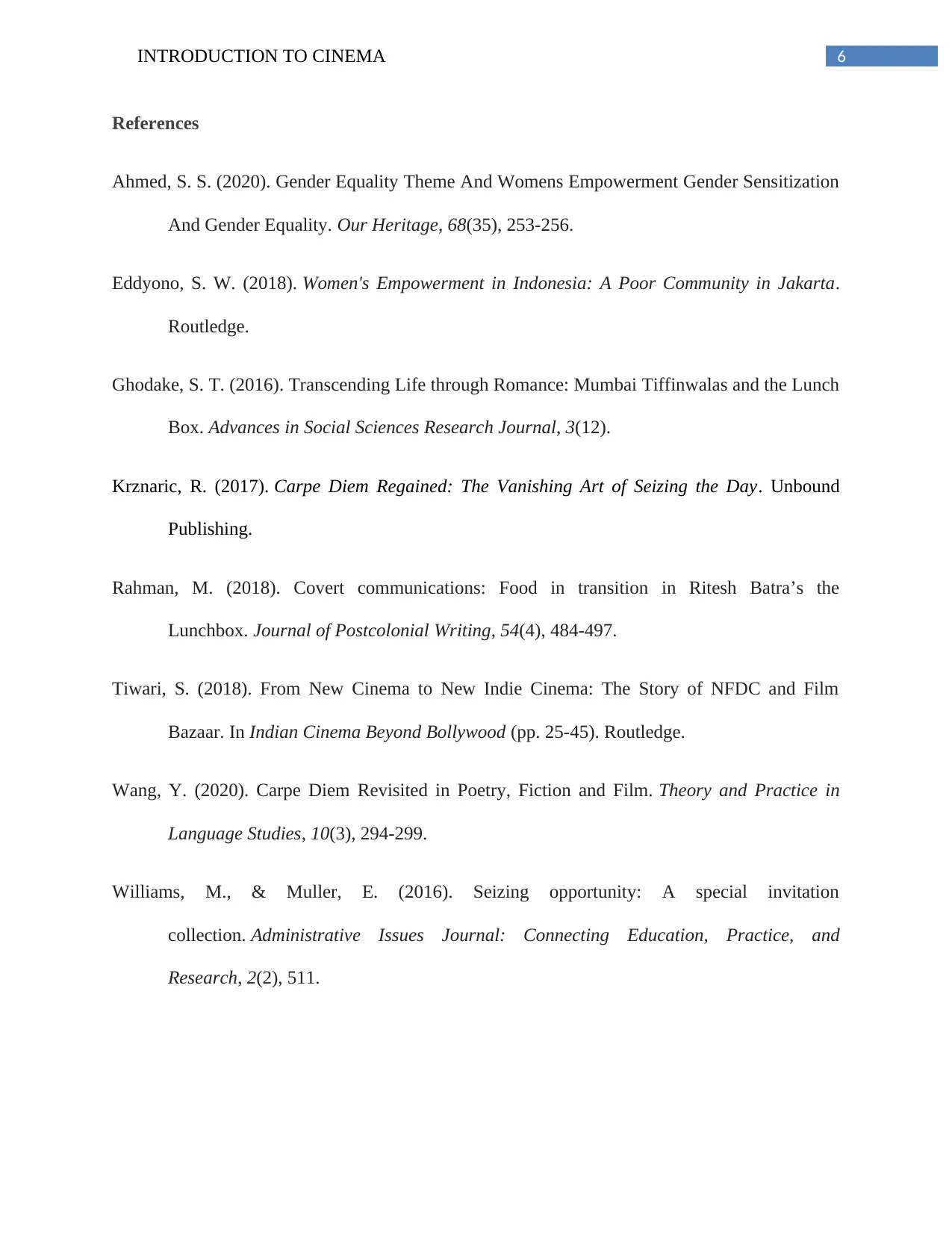
6INTRODUCTION TO CINEMA
References
Ahmed, S. S. (2020). Gender Equality Theme And Womens Empowerment Gender Sensitization
And Gender Equality. Our Heritage, 68(35), 253-256.
Eddyono, S. W. (2018). Women's Empowerment in Indonesia: A Poor Community in Jakarta.
Routledge.
Ghodake, S. T. (2016). Transcending Life through Romance: Mumbai Tiffinwalas and the Lunch
Box. Advances in Social Sciences Research Journal, 3(12).
Krznaric, R. (2017). Carpe Diem Regained: The Vanishing Art of Seizing the Day. Unbound
Publishing.
Rahman, M. (2018). Covert communications: Food in transition in Ritesh Batra’s the
Lunchbox. Journal of Postcolonial Writing, 54(4), 484-497.
Tiwari, S. (2018). From New Cinema to New Indie Cinema: The Story of NFDC and Film
Bazaar. In Indian Cinema Beyond Bollywood (pp. 25-45). Routledge.
Wang, Y. (2020). Carpe Diem Revisited in Poetry, Fiction and Film. Theory and Practice in
Language Studies, 10(3), 294-299.
Williams, M., & Muller, E. (2016). Seizing opportunity: A special invitation
collection. Administrative Issues Journal: Connecting Education, Practice, and
Research, 2(2), 511.
References
Ahmed, S. S. (2020). Gender Equality Theme And Womens Empowerment Gender Sensitization
And Gender Equality. Our Heritage, 68(35), 253-256.
Eddyono, S. W. (2018). Women's Empowerment in Indonesia: A Poor Community in Jakarta.
Routledge.
Ghodake, S. T. (2016). Transcending Life through Romance: Mumbai Tiffinwalas and the Lunch
Box. Advances in Social Sciences Research Journal, 3(12).
Krznaric, R. (2017). Carpe Diem Regained: The Vanishing Art of Seizing the Day. Unbound
Publishing.
Rahman, M. (2018). Covert communications: Food in transition in Ritesh Batra’s the
Lunchbox. Journal of Postcolonial Writing, 54(4), 484-497.
Tiwari, S. (2018). From New Cinema to New Indie Cinema: The Story of NFDC and Film
Bazaar. In Indian Cinema Beyond Bollywood (pp. 25-45). Routledge.
Wang, Y. (2020). Carpe Diem Revisited in Poetry, Fiction and Film. Theory and Practice in
Language Studies, 10(3), 294-299.
Williams, M., & Muller, E. (2016). Seizing opportunity: A special invitation
collection. Administrative Issues Journal: Connecting Education, Practice, and
Research, 2(2), 511.
⊘ This is a preview!⊘
Do you want full access?
Subscribe today to unlock all pages.

Trusted by 1+ million students worldwide
1 out of 6
Your All-in-One AI-Powered Toolkit for Academic Success.
+13062052269
info@desklib.com
Available 24*7 on WhatsApp / Email
![[object Object]](/_next/static/media/star-bottom.7253800d.svg)
Unlock your academic potential
Copyright © 2020–2025 A2Z Services. All Rights Reserved. Developed and managed by ZUCOL.